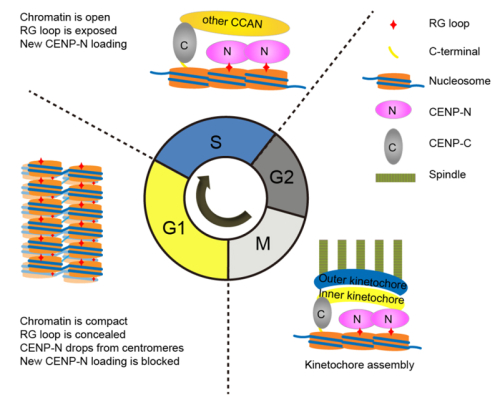
The centromere is a specialized chromatin domain that provides a platform for kinetochore assembly and microtubule attachment and plays a crucial role in chromosome segregation during mitosis. Centromere-specific histone H3 variant, centromere protein A (CENP-A), functions as an epigenetic mark for the formation and maintenance of centromeres.
Professor LI Guohong's group at the Institute of Biophysics (IBP) of Chinese Academy of Sciences revealed the dual function of CENP-A in the recruitment of CENP-N and the folding of centromeric chromatin. The group found that a CENP-A-specific RG loop (Arg80/Gly81) plays an essential role in the recruitment of CENP-N. CENP-A chromatin forms a featured “ladder-like” structure and the RG loop assists the formation of the “ladder-like” structure. CENP-N specifically binds to open CENP-A chromatin and compaction of CENP-A chromatin impairs the binding of CENP-N.
The researchers demonstrated that the higher-order organization of centromeric chromatin undergoes a structural transition from a compact state in Gap 1 (G1) phase to an open state in Synthesis (S) phase. They also verified that CENP-N is stably loaded in middle/late S phase. This structural transition of chromatin is consistent with the dynamic loading of CENP-N onto centromeres during the cell cycle. Thus they proposed that structural transitions of higher-order structure of centromeric chromatin orchestrate the temporal loading of CENP-N to centromeres via regulating the accessibility of the RG loop in CENP-A chromatin during the cell cycle.
This work provided critical insight to better understand the structure and function of centromeric chromatin and how the epigenetic information encoded in CENP-A-containing nucleosomes is read and transmitted.
The paper entitled “Structural transitions of centromeric chromatin regulate the cell cycle-dependent recruitment of CENP-N” was published in Genes & Development.
This study is supported by the Ministry of Science and Technology of China, the National Natural Science Foundation, and the Chinese Academy of Sciences.

Figure: Model for structural transitions of centromeric chromatinregulating the cell cycle-dependent recruitment of CENP-N (Image by IBP)

86-10-68597521 (day)
86-10-68597289 (night)

86-10-68511095 (day)
86-10-68512458 (night)

cas_en@cas.cn

52 Sanlihe Rd., Xicheng District,
Beijing, China (100864)

